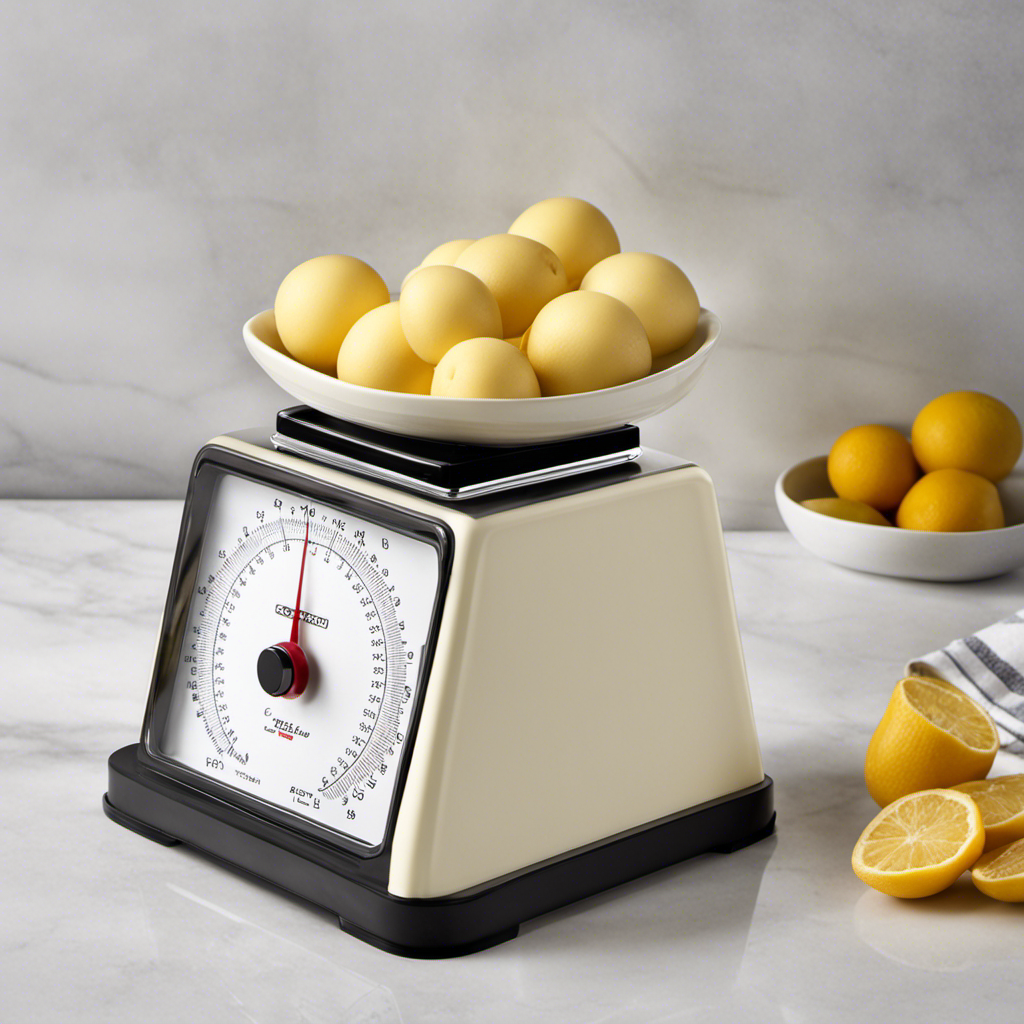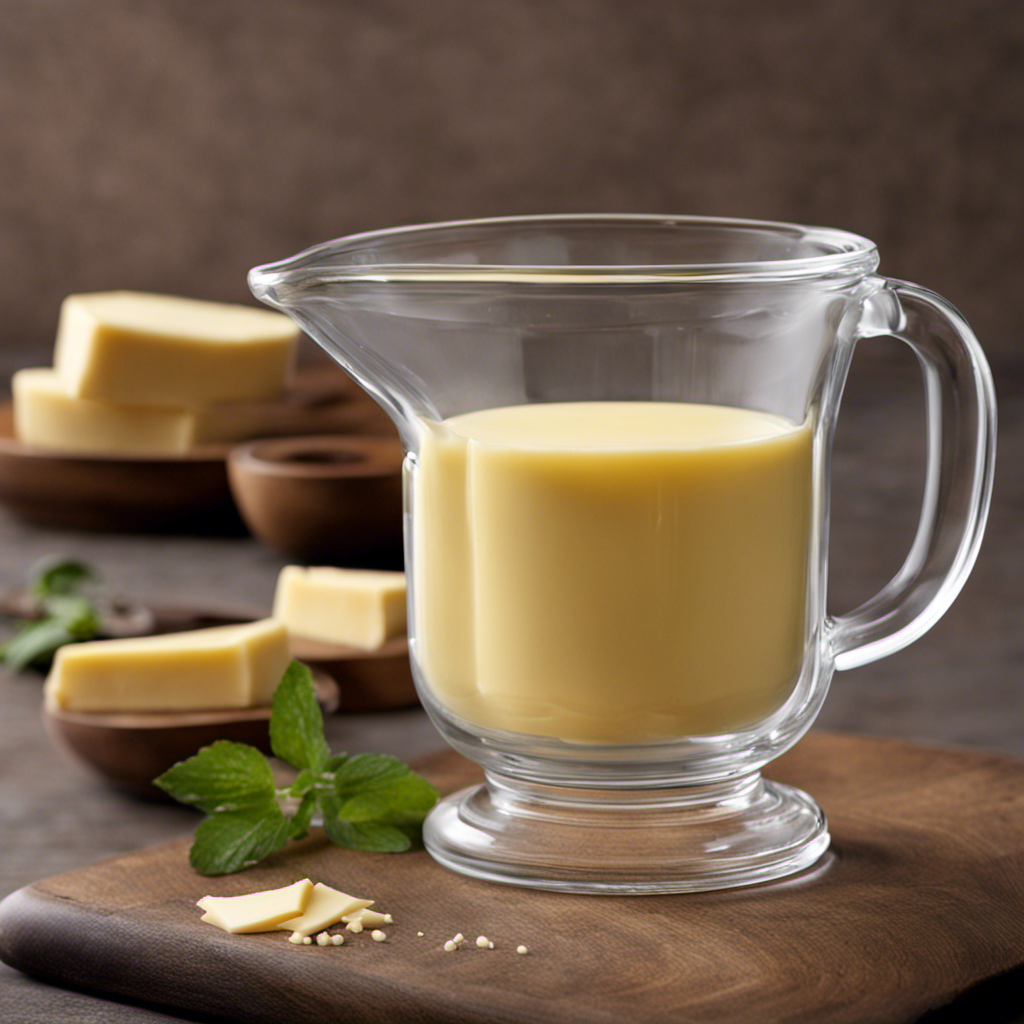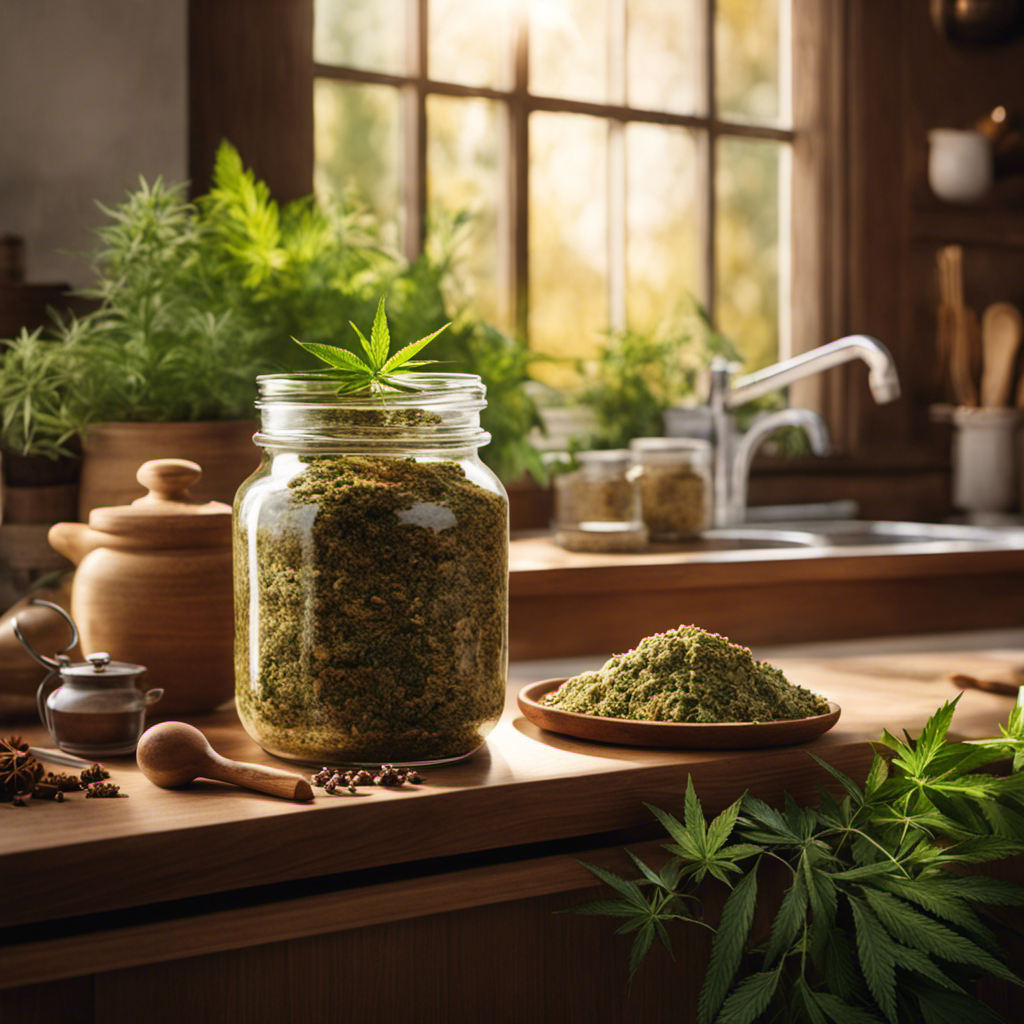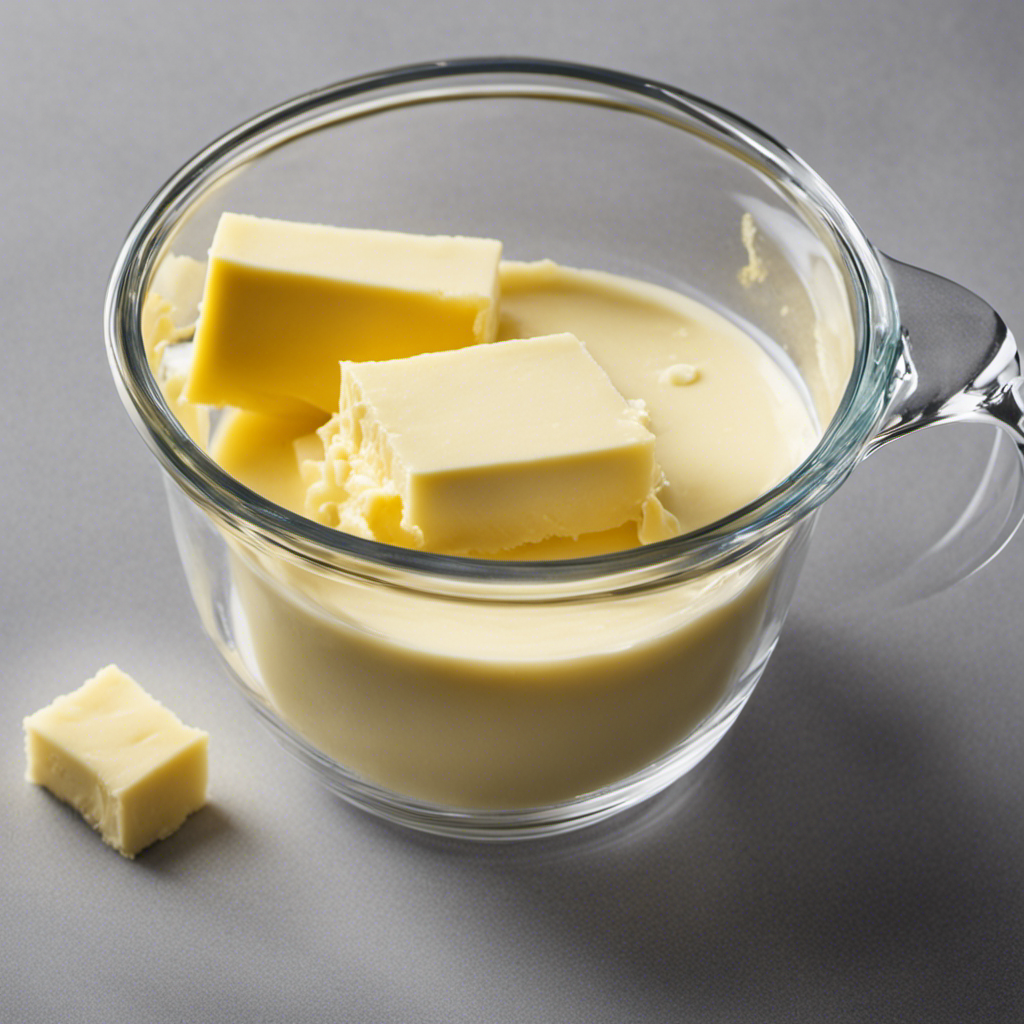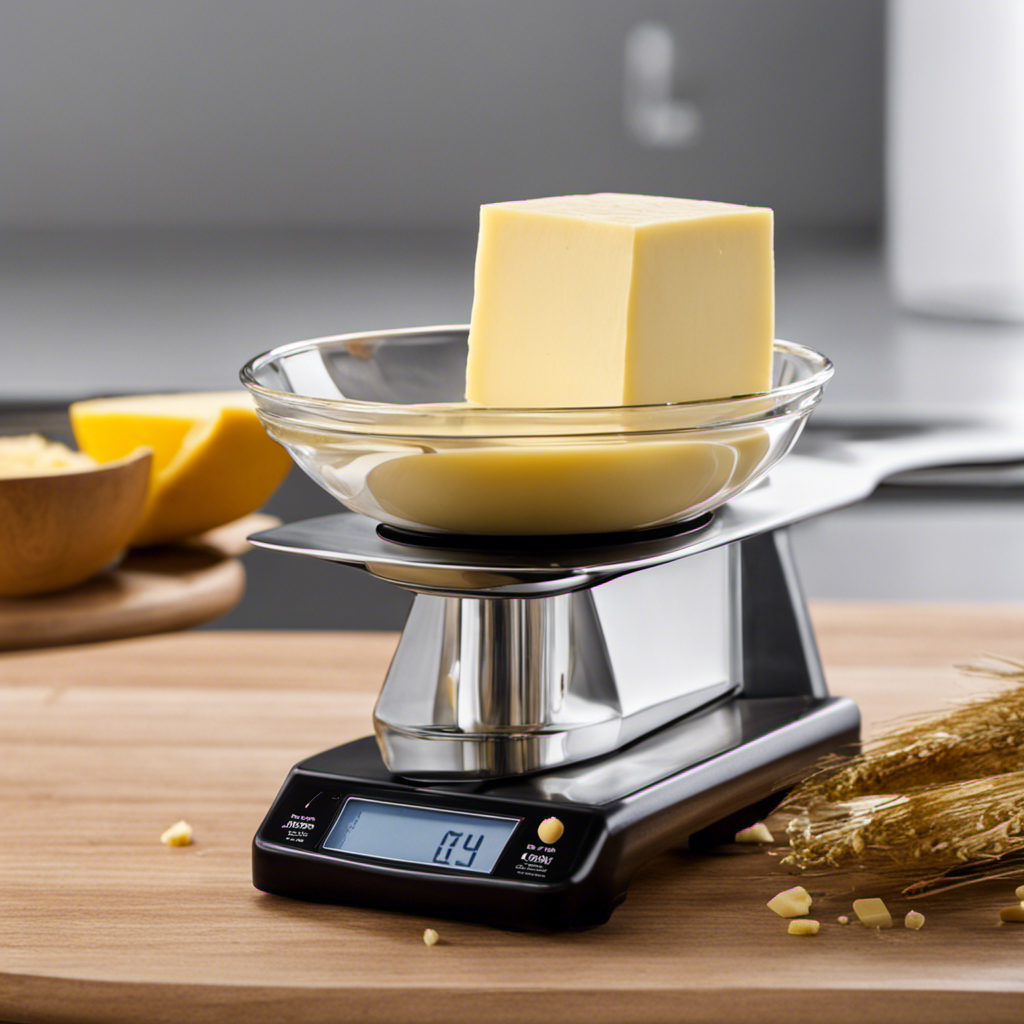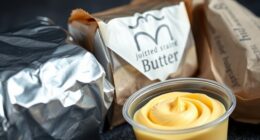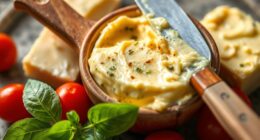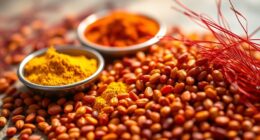Have you ever pondered the amount of butter incorporated into your cooking recipes?
Well, did you know that 500 grams of butter is equivalent to a little over two cups? That’s right, two cups of creamy, rich butter that can elevate your baked goods to a whole new level of deliciousness.
In this article, we’ll explore the different types of butter, teach you how to accurately measure it, and share some mouthwatering recipes that call for 500 grams of this golden ingredient.
So, let’s get started and dive into the world of butter!
Key Takeaways
- Butter is primarily made up of fat, specifically saturated fat.
- Excessive consumption of butter can increase the risk of heart disease due to high cholesterol levels.
- Butter contains essential vitamins like A, D, E, and K, as well as antioxidants.
- Accurate measuring of butter is crucial for precise baking, and kitchen scales are recommended for measuring butter.
Butter: A Brief Overview
Butter is a versatile ingredient that you can use for cooking, baking, or spreading on toast.
When it comes to nutrition, butter is primarily made up of fat, specifically saturated fat. This can contribute to high cholesterol levels and increase the risk of heart disease if consumed in excess.
However, butter also contains essential vitamins like A, D, E, and K, as well as antioxidants.
If you’re looking for alternatives to butter, there are several options available. Olive oil, coconut oil, and avocado are all healthy substitutes that can provide similar flavors and textures.
Margarine and vegetable spreads are also popular choices, but be sure to read the labels and choose options with less saturated fat and no trans fats.
Different Types of Butter
You can find various types of butter in the market. From traditional salted and unsalted butter to a wide range of flavored options, there is something for every taste preference.
Different butter flavors include garlic, herb, cinnamon, honey, and even truffle-infused butter. These flavors add a unique twist to your dishes, whether you’re spreading it on toast or using it for cooking and baking.
If you’re looking for butter alternatives, there are also plant-based options available such as vegan butter made from oils like coconut or avocado. These alternatives are perfect for those who are lactose intolerant or following a vegan diet.
Understanding Butter Measurements
Are you tired of guessing how much butter to use in your recipes?
In this discussion, we will explore the importance of accurate butter measuring and how to convert grams to cups for precise baking.
Knowing the right amount of butter to use can make a significant difference in the texture and taste of your baked goods, so let’s dive in and learn the tricks of the trade.
Accurate Butter Measuring
Accurate measuring is crucial when determining the amount of butter needed. To ensure precise measurements, it is essential to use proper measuring techniques.
One common mistake people make is using the wrong measuring tool. Using measuring cups for butter is not accurate because butter has a different density compared to water. Instead, it is recommended to use a kitchen scale to measure butter.
Another mistake to avoid is not using the correct unit of measurement. Most recipes call for butter to be measured in grams or ounces, so make sure to convert if necessary.
Converting Grams to Cups
To convert grams to cups, it’s helpful to know the conversion factor for the specific ingredient you’re working with. The conversion factor may vary depending on the density of the ingredient. Here are some common conversion factors for converting grams to cups:
- Flour: 1 cup = 120 grams
- Sugar: 1 cup = 200 grams
- Butter: 1 cup = 227 grams
- Milk: 1 cup = 240 grams
- Water: 1 cup = 240 grams
Keep in mind that these conversion factors are approximate and can vary slightly depending on the ingredient and how it is measured. It’s always a good idea to double-check with a reliable recipe or conversion chart for accurate measurements.
Now that you know how to convert grams to cups, let’s explore how to convert grams to other units.
Converting Grams to Other Units
Converting grams to other units can be a helpful skill when cooking with specific measurements. It allows you to accurately measure ingredients and follow recipes with precision. Two common conversions you may come across are converting grams to tablespoons and converting grams to ounces. To make things easier, here is a handy table to help you with these conversions:
| Grams | Tablespoons | Ounces |
|---|---|---|
| 10 | 0.67 | 0.35 |
| 20 | 1.33 | 0.71 |
| 30 | 2 | 1.06 |
Converting grams to tablespoons and ounces can vary depending on the ingredient, but this table provides a general guideline. Remember, it’s always a good idea to double-check specific conversions for different ingredients. Now that you know how to convert grams to other units, let’s move on to some tips for accurately measuring butter.
Tips for Accurately Measuring Butter
When measuring ingredients, it can be helpful to soften the butter beforehand. Softened butter is easier to measure accurately and will blend more smoothly into your recipes.
Here are some measuring tips to ensure you get the perfect amount of butter every time:
-
Use a kitchen scale: Weighing the butter is the most accurate way to measure it, especially when precision is important.
-
Use the markings on the butter wrapper: Most butter wrappers have measurements marked on the sides, allowing you to easily cut the desired amount.
-
Use a measuring spoon: If you don’t have a scale or the butter is already soft, you can use a measuring spoon to scoop out the required amount.
-
Pack it tightly: When measuring butter in a measuring cup, make sure to pack it firmly to avoid any air pockets.
-
Avoid common mistakes: Don’t use melted butter as it will affect the texture of your recipe. Also, make sure to level off the top of the butter when measuring to ensure accuracy.
Recipes That Use 500 G of Butter
There are several delicious recipes that call for 500 grams of butter.
One such recipe is a classic butter cake. To make this cake, you’ll need to cream the butter with sugar, then add eggs, flour, and baking powder. The result is a rich, moist cake with a buttery flavor that is perfect for any special occasion.
Another recipe that uses 500 grams of butter is shortbread cookies. These buttery treats are simple yet incredibly tasty. Just mix the butter with sugar, flour, and a pinch of salt, then shape the dough into cookies and bake until golden brown. With their melt-in-your-mouth texture, these cookies are sure to be a hit.
Conclusion
In conclusion, understanding the measurements of butter is crucial for successful cooking and baking.
One interesting statistic to note is that 500 grams of butter is equivalent to approximately 2 1/4 cups or 1 pound.
This emphasizes the importance of accurate measurement when following recipes, as even a slight difference in the amount of butter can significantly affect the outcome of a dish.
By using the proper measurements, you can ensure the perfect texture and flavor in your culinary creations.
